Green Globes Certification Overview
Enabling sustainability for all building types
![]() Continuing Education
Continuing Education
Use the following learning objectives to focus your study while reading this month’s Continuing Education article.
Learning Objectives - After reading this article, you will be able to:
- Recognize the environmental and occupant/tenant benefits of green building certification.
- Identify the attributes of green building certification programs that make them applicable to all building types.
- Explain how GBI’s online survey tools facilitate Green Globes certification.
- Describe the Green Globes assessment process and locate additional user support.
Buildings in the United States account for nearly half of our national energy use and greenhouse gas emissions. They also contribute 65 percent of the waste our nation produces and consume 12 percent of our potable water. In response to this reality, more and more building owners and operators are using third-party green building certification programs to optimize and assess the environmental attributes and performance of new construction and existing buildings. The benefits associated with green building certification are not only to minimize environmental impacts but also to reduce operating costs, improve tenant retention, optimize occupant comfort, and enhance employee performance, while increasing the property’s value.
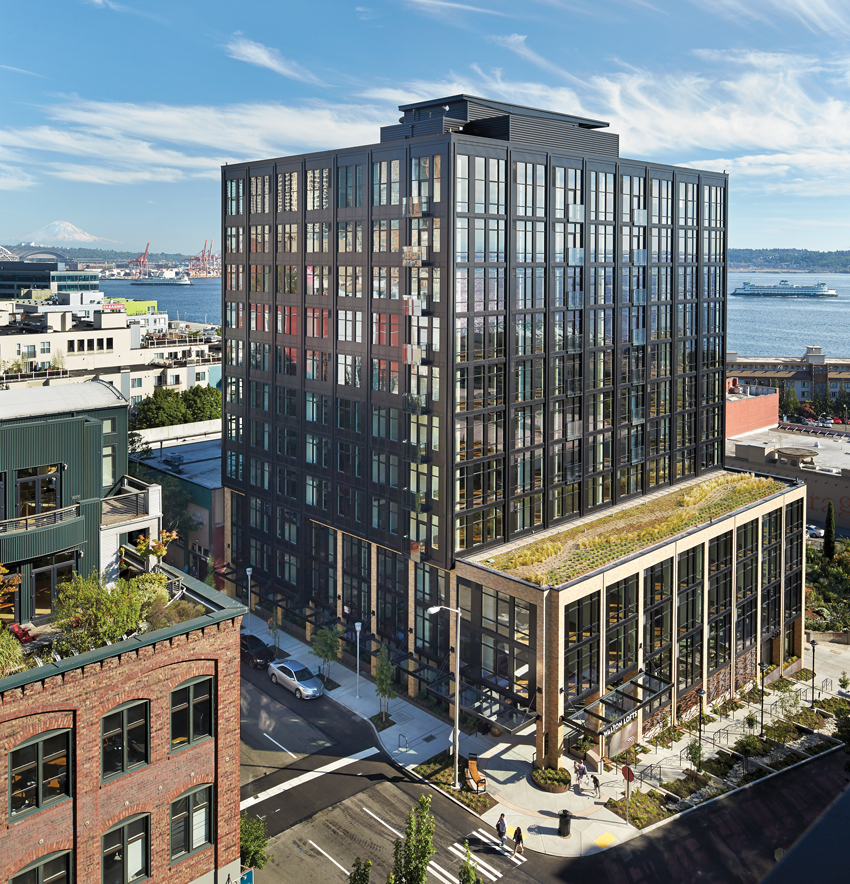
© Benjamin Benschneider Photography
Walton Lofts in Seattle achieved Three Green Globes for New Construction.
Green Building Authorities Add Value to Owners
The Green Building Initiative (GBI), a nonprofit organization founded in 2004 to accelerate adoption of green building best practices, provides third-party green building certifications and tools that act as roadmaps for architects, builders, and property owners so that sustainability goals are identifiable, achievable, and measurable throughout the entire life cycle of the building. There are several third-party certification programs in the United States market that overlap in their goals of promoting adoption of sustainable technologies and practices, and this course strives to support understanding of how key factors, such as flexibility and support services, can contribute to deciding which program will best match with the building or project.
GBI's Green Globes is a Nationally Recognized Certification Program
Among the leading national programs is the GBI’s Green Globes, North America’s first interactive design guidance, environmental assessment, and certification program. Green Globes assists in the design and evaluation of sustainable, high-performance buildings by:
- Increasing awareness of environmental issues with owners, designers, and operators
- Incentivizing achievement of energy, water and other performance objectives
- Providing third-party assessment of design, construction, and operations practices, which keeps teams on track in achieving goals
- Recording actionable suggestions for improvement at varying stages of project delivery through customized assessment reports
- Maximizing owner and investor value through achievement of a certified building

Image courtesy of Green Building Initiative
GBI acquired the rights to bring Green Globes to the United States in 2004. The United States version evolved from the Canadian Green Globes program, a web-based, interactive green building tool based on Building Research Establishment Environment Assessment Method (BREEAM). BREEAM, which was developed in the United Kingdom in 1990 and was the world’s first sustainability assessment method for buildings, has achieved global recognition. Today, there are Green Globes certified buildings throughout the United States and Canada.
Since its launch in the United States, Green Globes has grown in relevance and impact. In 2012, a study commissioned by the federal General Services Administration (GSA) determined that GBI’s Green Globes met the requirements of the federal government. As a result, GSA and DOE issued statements recognizing Green Globes as well as the U.S. Green Building Council’s LEED rating system as the only two systems approved for use for federal buildings. Today, GBI’s public sector clients include federal government agencies, such as Veterans Affairs, DHHS, DOE, NASA, NIH, and the Forest Service. Also, various state, county, and city governments include Green Globes in their incentive programs and have used Green Globes to certify their own buildings. Private sector users of Green Globes include Fidelity Investments, Jones Lang LaSalle, Whole Foods Market, Internap, and Drexel University.

© Mitsubishi
Mitsubishi Electric’s business headquarters and warehouse in Suwanee, Georgia, earned Two Green Globes for New Construction.
Green Globes is Applicable to All Building Types
Green Globes programs are available for New Construction, Existing Buildings, and Sustainable Interiors (tenant improvements). Green Globes has been used on a myriad of building types and portfolios, including offices, warehouses, data centers, hospitals, laboratories, hospitality/multifamily, grocery stores, and mixed-use retail.
As a credible, practical, and cost-effective green building rating system, Green Globes has several unique features to allow building owners and managers to focus on addressing those aspects of sustainability most suited to achieving their operational goals.
Green Globes Provides
- Collaborative approach throughout the assessment process: Collaboration with a green building authority is important, and Green Globes is unique because it promotes sustainable thinking throughout planning and delivery, while fostering an interactive process. Each building is assigned a GBI staff person as project manager and a third-party assessor as a technical expert.
- Weighted 1,000-point based system in lieu of prerequisites: Instead of requiring that teams use one specific approach, which can eliminate some buildings from even considering green certification, Green Globes assigns high point values to incentivize achievement of criteria deemed most critical to high-performing, green buildings. The point system incentivizes teams to apply green building best practices to every building, regardless of size, type, or budget.
- Non-applicable options that increase the flexibility of the rating system: Green Globes offers increased flexibility with the ability to enter a Not Applicable designation when appropriate. Assessment criteria can be noted as non-applicable when local codes conflict or a criterion addresses a technology that is not appropriate for the building (e.g., cooling systems if the climate or building type doesn’t require their use).
- Online, interactive survey tool that acts as a user-friendly roadmap: The surveys generate discussion on how to achieve optimal energy conservation, water use efficiencies, responsible materials use, occupant comfort, and project team efficiencies.
- Reliable and tested criteria, pathways, and references: Green Globes incorporates content from ANSI/GBI 01–2010: Green Building Assessment Protocol for Commercial Buildings and references other American National Standard Institute (ANSI) approved consensus standards as the basis of benchmarks throughout the rating system. GBI, as an accredited standards developing organization through ANSI, incorporates and responds to input from hundreds of public commenters.1 Additionally, GBI believes strongly that the best science and research is made available through open, audited consensus processes. To that end, GBI is conducting a revision of the ANSI/GBI 01-2010 standard that will become the next version of Green Globes for New Construction.
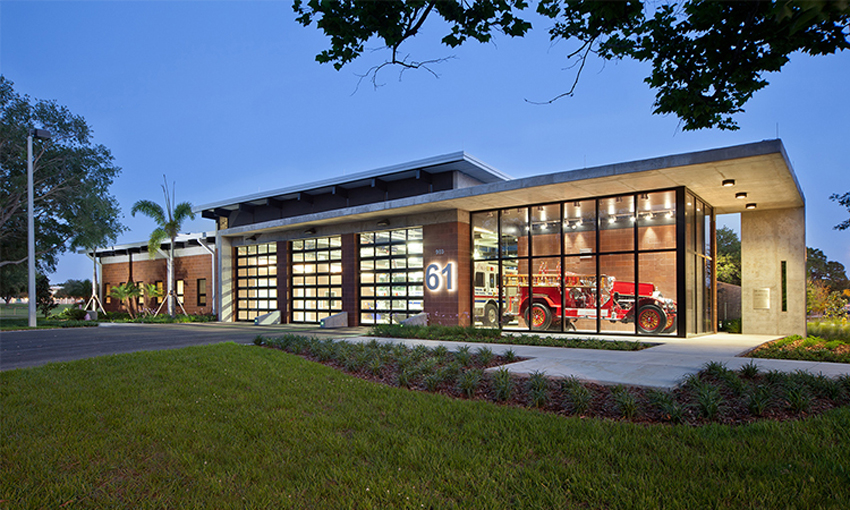
© WannemacherJensenArchitects
For Dunedin Fire Station 61 in Dunedin, Florida, the city sought to uphold its values and turned to Green Globes to make smart use of public funds, earning One Green Globe.
Financial Return on Investment for Green Globes Certified Buildings
Green Globes certified buildings are attractive to a growing group of tenants and individual buyers, making these assets more valuable.
According to the Appraisal Institute’s recent publication, Green Building and Property Value: A Primer for Building Owners and Developers, “In many markets, rental premiums are emerging in green buildings, as many of today’s best tenants are increasingly willing to pay a premium for green spaces. For these tenants, leasing green space is an opportunity to demonstrate a commitment to sustainability, attract the best employees, and improve productivity.” The report concludes that “National studies for commercial office buildings back up this trend on rents and occupancy, as certified green buildings outperform their conventional peers by a wide margin.”
With this in mind, it is no wonder that financial institutions have taken notice. For example, Fannie Mae gives preferential pricing for all green loans and reduces the fixed interest rate of a multifamily refinance, acquisition, or supplemental mortgage loan if the building is Green Globes certified. As of May, 26 2016, a $10 million conventional green loan would receive an interest rate that is 33 basis points (0.33 percent) lower than a comparable non-green loan. The amount of the interest rate reduction varies based on the size and credit quality of the loan and may change over time but can be as high as 40 basis points.2
In addition, Building Owners and Managers Association of Canada (BOMA Canada) data indicates that buildings certified in 2011 using a Green Globes protocol average 16 percent less energy consumption than average commercial buildings, use 55 percent less water, and divert 60 percent more waste than typical commercial buildings (although such results are not guaranteed).3
More Value with Green Globes Experts
All those who have worked on projects seeking green rating certification know that green building professionals are an indispensable part of the team. That is why GBI has a trained professional network that supports the growth of green building certifications and increases national awareness of green building best practices. Earning a professional Green Globes designation through GBI is a way to demonstrate a clear understanding of how the Green Globes certification and assessment process works.
One designation available is the Green Globes Professional (GGP). GGP candidates must possess at least five years of experience working with commercial buildings in the areas of architecture, engineering, construction management, facility management, energy analysis, commissioning, sustainability management, or another related area. The GGP program is entirely online and self-paced and has been approved by the American Institute of Architects (AIA) for 8 LU/HSW continuing education credits. One training program covers all of the Green Globes modules.
Additionally, Green Globes Assessors (GGAs) are key to the user-friendly Green Globes experience. GGAs are technical experts contracted by GBI to perform independent third-party assessments for Green Globes building projects. Assessors have at least 10 years of experience in the areas of sustainable design, construction, energy, and facility management; remain current on trends in sustainability best practices and innovations; and are typically licensed architects or engineers. Working with the project team in real time, assessors do much more than verify achievements—they also serve as a resource for questions, offer guidance for improvements, and cross-pollinate green building concepts to create holistic solutions.
After first certifying as a GGP, Green Globes Assessor candidates complete extensive training in:
- Green Globes assessment methodology for New Construction and/or Existing Buildings
- Conducting on-site assessments, including review of documentation and actual building features
- Creating customized and comprehensive assessment reports
In addition to the assessor, every building is assigned a GBI project manager to guide administration of the Green Globes process and ensure things are always moving forward.
The Green Globes Process
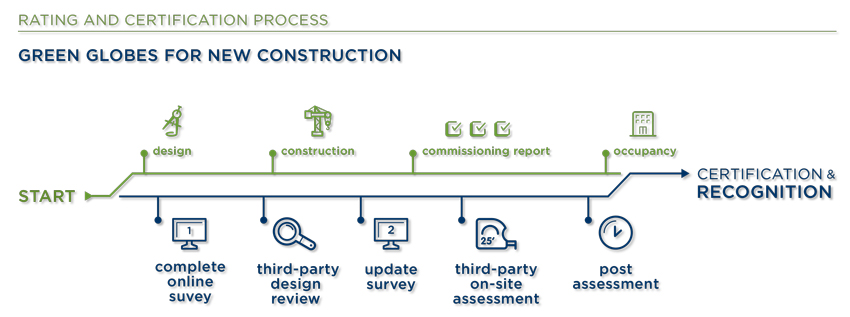
© Green Building Initiative
Examination of the Green Globes for New Construction (NC) module facilitates understanding of Green Globes’ unique tool and process. As mentioned previously, the NC program employs a comprehensive evaluation and scoring method based on a 1000-point system. In addition, there are distinct phases within the assessment process, including use of a survey tool to estimate the number of points the building may achieve and completion of a required on-site walk through with the GGA.
The Basics
What are the boundaries? Green Globes NC assessment projects are typically enclosed, permanent, commercial structures with at least 400 square feet of conditioned space that are designed for human occupancy and have been occupied for less than 18 months.
What are the surveys? The New Construction assessment program includes four online, interactive surveys: Pre-Design, Schematic Design, Construction Documents, and Post-Construction.
- The first two surveys, Pre-Design and Schematic Design, are optional and are not scored. They are intended to guide project teams through the design process and help them understand the Green Globes assessment requirements.
- The next two surveys, Construction Documents (CD) and Post-Construction (PC), are identical but are completed at different phases in the construction process (before and after) to track any design changes made during construction. Unlike the optional surveys, the CD and PC surveys are scored and are required as part of the assessment process. The CD and PC surveys each have two versions—one for the client and one for the assessor—so a record of the responses from each party is retained.
What do I do? What does the assessor do? The Green Globes NC assessment process requires two separate stages: 1) a Design Review of the construction documents, and 2) an On-Site Assessment to meet with the project team and tour the completed building.
- A project team lead will need to ensure that the construction documents survey is complete and accurate and provide supporting documents. Using a GGP as team lead is helpful.
- During the Design Review (Stage I), the third-party assessor will review the client’s CD survey responses and verify them using the supporting documentation provided. The assessor will write a comprehensive report that includes a preliminary score, a list of criteria that require additional documentation or visual inspection for verification, and suggested improvements for consideration.
- The On-Site Assessment (Stage II) occurs when construction on the building has reached substantial completion. The assessor will meet with the key project team members to review the Post-Construction survey, collect any documentation that was missing during Stage I, and tour the building. The assessor will then write a detailed report that includes the final Green Globes score and rating as well as recommendations for future improvement.

© Green Building Initiative
Green Globes Assessors visit every building for the on-site assessment.
Scoring Protocols
Green Globes offers four rating levels, which are based on achieving a minimum of 35 percent of applicable points within the 1,000-point system.
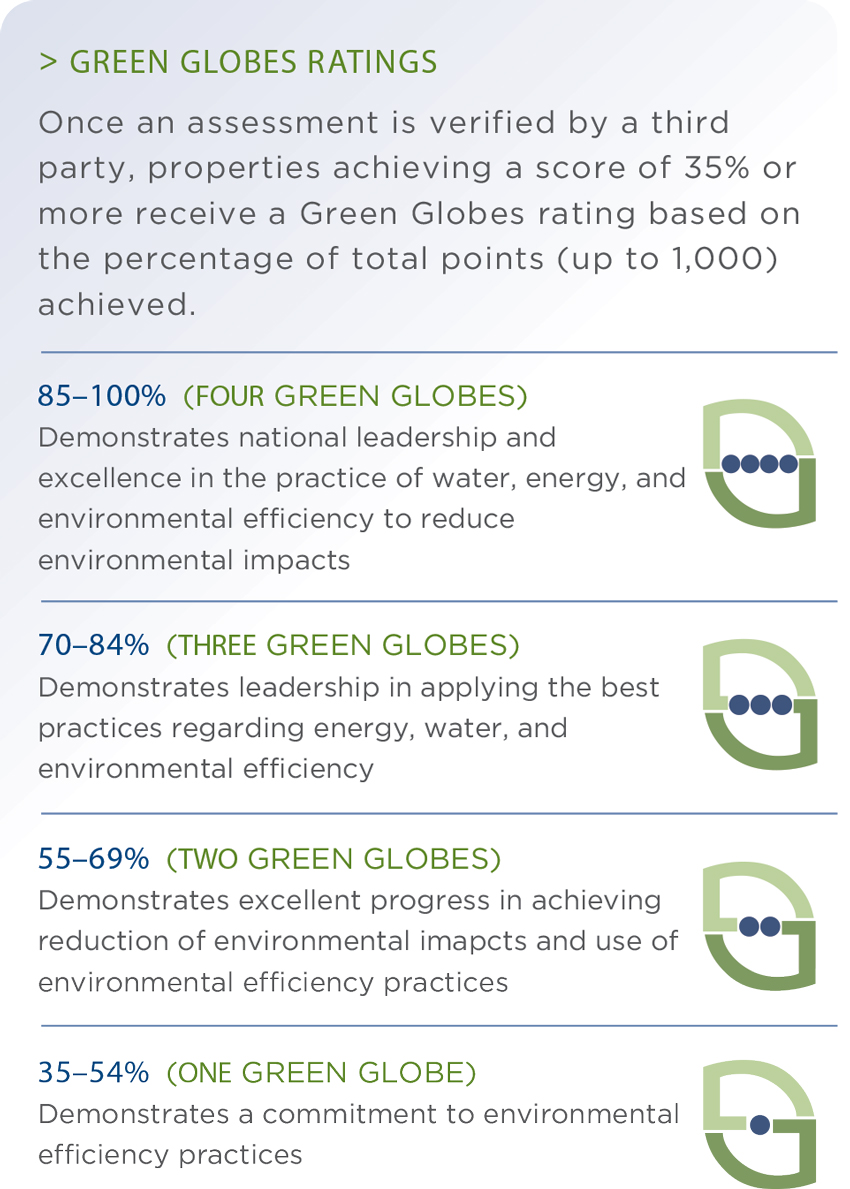
© Green Building Initiative
The points are spread over environmental assessment areas, including project management, site, energy, water, materials, emissions, and indoor environment.
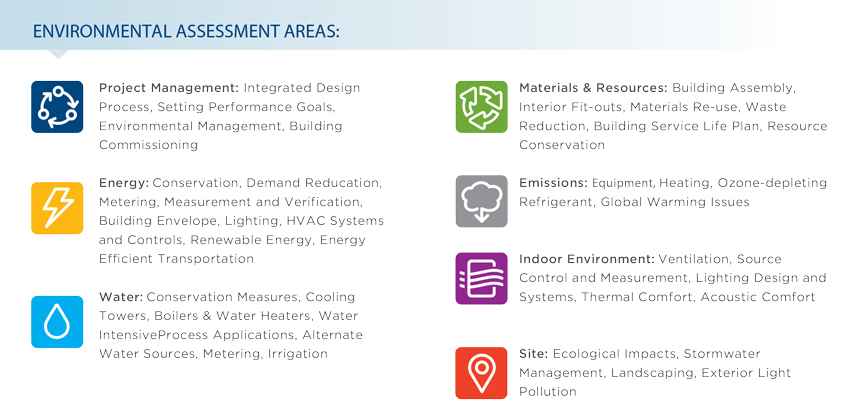
© Green Building Initiative
A Few Assessment Area Highlights
Energy
Energy is the most heavily weighted category and aims to accommodate the widest possible range of building occupancy types, sizes, and other considerations. To achieve the maximum score for Energy, the team can follow one of four possible paths for assessing designed (intended) energy performance. These tracks include ENERGY STAR, ASHRAE 90.1, a recently introduced program named ASHRAE bEQ, and the GBI ANSI Standard Path A protocol, which allows the designer to derive a projected energy performance in units of CO2 emissions.
In addition to energy performance, the NC program evaluates prescriptive criteria related to energy efficiency implementation strategies, including space optimization, microclimatic design, energy-efficient equipment, lighting selection and strategy, high-performance building envelope selection, metering and peak load demand efficiencies, and integrating renewable energy.
Indoor Environment
Another heavily weighted assessment area is Indoor Environment. According to the ANSI/GBI 01-2010 standard, indoor environmental quality refers to “the quality of the air and environment inside buildings, based on pollutant concentrations and conditions that can affect the health, comfort and performance of occupants, including temperature, relative humidity, light, sound, and other factors.”4
Therefore, this assessment area provides guidance on how to create healthy interior spaces through proper ventilation, pollutant source control and measurement, daylighting, and thermal and acoustic comfort. Notable features of this section include compliance with updated volatile organic compound (VOC) content thresholds to minimize indoor pollution, assurance that ventilation systems meet ASHRAE 55 2010 standards, and verification that thermal comfort is updated to match ASHRAE90.1 2010.
Project Management
The Project Management area of Green Globes NC emphasizes the importance of planning and coordination in achieving sustainability objectives. The area is divided into five categories: Integrated Design and Management, Environmental Purchasing, Whole Building Commissioning, Environmental Management (including Post-Construction phase), and Emergency Response Planning. This assessment area reflects GBI’s understanding that positive sustainability outcomes are only possible when sound management practices are firmly in place on an institutional level. In addition, Green Globes emphasizes the importance of commissioning to ensure that the building and its systems are operating as intended not only during construction but well into post-construction and over the course of the building’s service life.
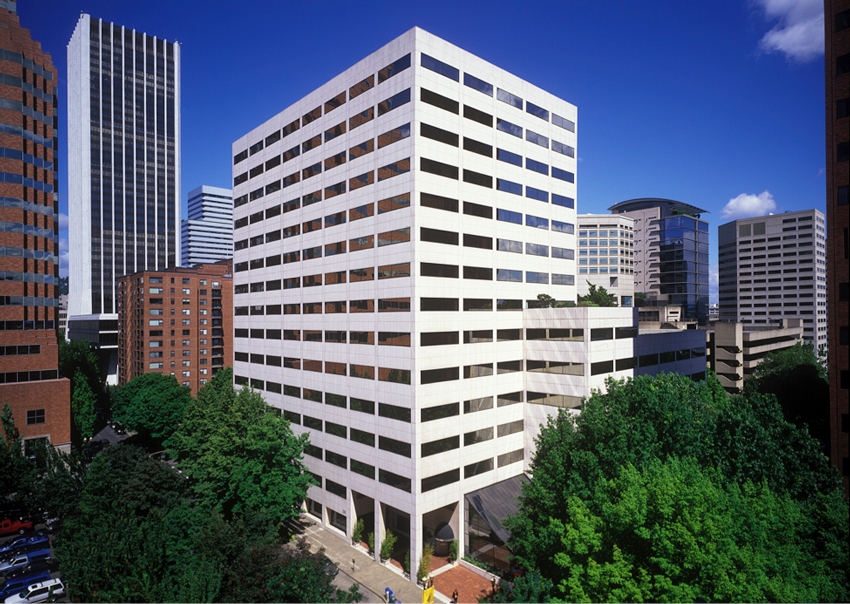
© Melvin Mark
The Crown Plaza building in Portland, Oregon, is an office building that earned Four Green Globes for Existing Buildings.
Site
The Site assessment area measures the building’s ecological impacts, including how the construction process and building use will affect soil erosion, urban heat islands, light pollution, and stormwater runoff. The Site category also provides guidance and awards points for environmental enhancements, such as pervious pavements for stormwater management, vegetated roofs to combat urban heat island effect, and xeriscape landscape design and gray water irrigation systems to reduce water demand.
Water
Like the Energy assessment area, the Green Globes for New Construction Water assessment area also evaluates both performance and prescriptive criteria. The program awards points for water conservation through the integration of EPA Water Sense high-efficiency plumbing, fixtures, fittings, appliances, and equipment. Additionally, because water demand varies widely based on a building’s function, the water area contains several sections that accommodate these differences. The water section encourages consideration of opportunities for water performance improvement over a baseline. Suggestions may include alternate water sources or recycling, metering and submetering options, and water-saving irrigation design methods.
Materials and Resources
The Materials and Resources assessment area also allows the use of a performance path or prescriptive path to evaluate the project’s sustainable attributes. Furthermore, the Building Assembly (core and shell) and the Interior Fit-Out (finishes, furnishings, partitions) are assessed separately, allowing different approaches (performance or prescriptive) to be taken for each. The performance path employs life-cycle assessment (LCA), whereas the prescriptive path employs the use of EPDs or other third-party certifications. The Materials area encourages multi-attribute approaches, use of the Athena Impact Estimator, use of locally sourced materials (within 500 miles), and construction and use-phase waste reduction.
Emissions
The Emissions assessment area evaluates comprehensive heating equipment and refrigerant management practices. The section also places an increased emphasis on reducing Global Warming Potential by following the steps outlined in the EPA’s GreenChill program. GreenChill is a joint program between food retailers and the EPA to reduce refrigerant emissions and their negative impacts on the ozone layer.5
Revisions are Underway
Through revision of the ANSI/GBI 01-2010 standard, GBI is anticipating changes to the rating system that will likely include the elimination of the Emissions Assessment Area as a separate category and the additional requirement that buildings earn a minimum of 20 percent of applicable points in each of the environmental assessment areas. Other innovations include addressing owner risk issues, such as resilience and life-cycle costs.
Green Globes Certification for Existing Buildings, Interiors, and Federal Government
In addition to Green Globes for New Construction, GBI offers assessment programs for existing buildings (including health care), sustainable interiors, and federal government buildings.
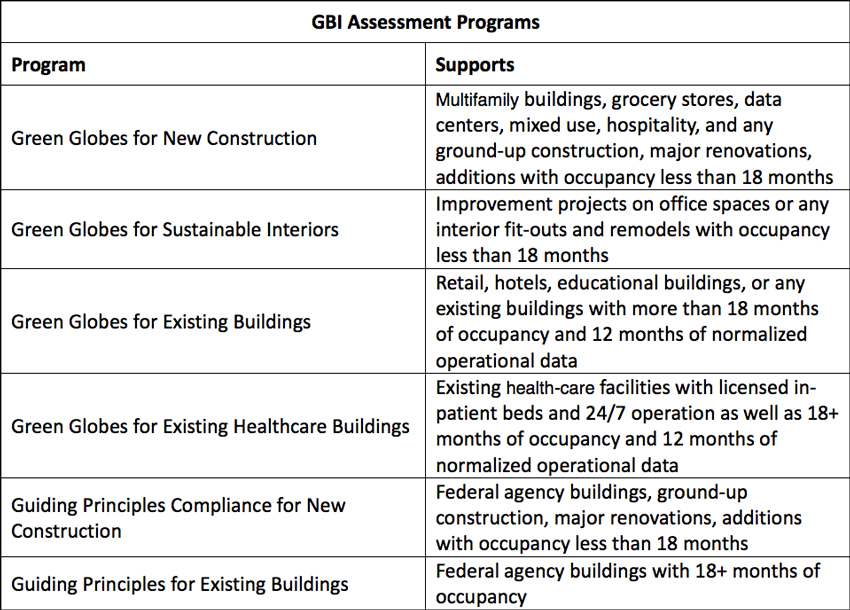
Green Globes for Existing Buildings (EB) assessment involves a single review by a third-party assessor as opposed to the two separate reviews required for NC. During this review, the assessor visits the site to meet with the project team, tours the building, examines the facility management documentation and utility bills, and verifies the client’s online survey responses using all the information collected. The assessor then writes a detailed report that includes the final Green Globes score and rating as well as recommendations for future improvement as capital funds become available. This report establishes a benchmark and evaluates new opportunities for energy efficiency and overall reduction of environmental impacts. The report integrates corporate goals and practices and guides ways to improve performance.
Like Green Globes NC, the EB program is based on a 1,000-point system with no prerequisites and requires a minimum overall score of 35 percent for certification.
Green Globes for Sustainable Interiors (SI) is very similar to Green Globes NC but has a more narrow focus that is limited to the Interior Fit-Out (finishes, furnishings, partitions) of a tenant space. SI is designed to assist interior architects and interior designers in achieving their sustainability goals for a fit-out project.
GBI also offers an assessment program specifically tailored to existing healthcare facilities as well as specialized Guiding Principles Compliance programs for federal agencies to measure their compliance with Executive Order requirements. As with all GBI programs, these are designed to streamline the management and documentation process and minimize the amount of time and effort project personnel spend on the assessment process. More than 500 federal buildings have been assessed using GBI programs.
Conclusion
In the realm of green building rating systems, Green Globes offers user-friendly, credible, and practical approaches to achieving certification. Green Globes provides in-depth, real-time support from GBI staff and third-party assessors throughout the assessment process to ensure the project team understands what is expected and has all of its questions answered.
Green Globes certification is available for new construction projects, existing buildings, and interiors spaces and assigns scores based on a weighted 1,000-point scale. The system has no prerequisites and allows nonapplicable designations so that projects teams are not penalized for criteria that do not apply to them.

© OTJArchitects
This office space is certified with Two Green Globes for Sustainable Interiors.
The Green Globes online survey tool and required site visit minimize the documentation needed, streamline the assessment process, and expedite building certification.
Green Globes is uniquely tailored to improve project management efficiencies and it emphasizes the achievement of environmental project goals in an efficient and cost-effective manner.
GBI’s suite of rating systems can help a client reduce environmental impacts and operating costs; qualify for tax and permitting incentives; meet government requirements; improve occupant comfort, productivity, and health; attract and retain employees; and increase property values.
End Notes
1American National Standards Institute (ANSI). Green Building Intiative. Web. 21 October 2016. www.thegbi.org/ansi.
2Green Globes: Multifamily Incentive Overview. Green Building Intiative. Web. 21 October 2016. www.thegbi.org/files/training_resources/GreenGlobes-Fannie_Mae_Overview.pdf.
3“Building Energy and Environmental Report 2011.” BOMA. Web. 21 October 2016. http://bomacanada.ca/bomabest/.
4Global Encasement Inc. Web. 21 October 2016. www.encasement.com/glossary/ieq.
5About GreenChill. U.S. Environmental Protection Agency. 7 December 2015. Web. 21 October 2016. www.epa.gov/greenchill/about-greenchill.
6Green Globes: Project Profile. Green Building Intiative. Web. 21 October 2016. www.thegbi.org/content/misc/ProjectProfile-GreenGlobes-Jospeh_Arnold_Lofts.pdf.

|
The Green Building Initiative (GBI) is a nonprofit organization dedicated to accelerating the adoption of building practices that result in resource-efficient, healthier, and environmentally sustainable buildings. We advance this mission through credible and practical green building approaches for more sustainable communities. To learn more, visit www.thegbi.org. |






